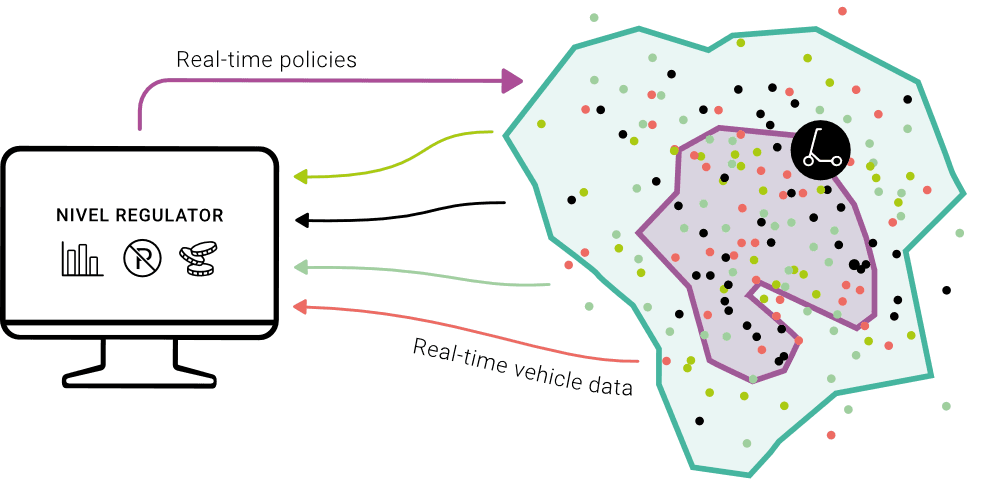The Nivel products for cities, citizens and mobility operators for tidy and safe streets
Nivel offers a complete suite of tools to keep your streets tidy: Nivel Regulator, Poor Parking App, and Task Manager
For cities to set and communicate regulations to all micromobility operators digitally. Add and adjust any regulation in a few clicks. The policies are being sent to all operators once activated over a standardised dataset.
Common regulations
Creating no-parking and no-go zones to keep parks, graveyards and soccer fields tidy. If the main hotspot is the city centre, cities can consider setting the inner zone as a general no-parking zone and allow parking only in designated parking areas.
Additionally, cities can set slow zones, for example for areas with a lot of pedestrians to prevent accidents.
The city may also set a fee for each vehicle. Like street cafés, they use valuable public space and should pay their fair share for this. For particular impact, a city may charge higher fees for scooters in the city centre and subsidise those scooters in the outer zone. In doing so, the city centre becomes less crowded, and people on the outskirts get an improved transportation service.
Nivel Regulator analytics
The analytics module within the Nivel Regulator allows cities to monitor the overall fleet numbers and utilisation of the shared vehicles and the public space. This will in turn give you input to policy updates - or new urban development in the long term.
How many scooters are ready to be used on your streets? Get real-time data on the number of vehicles that are available, the time vehicles are available and the trips per vehicle per day.
How are the vehicles being utilised? Get insights on the number of total trips, trips per vehicle, the average trip duration, average trip length (m) and average trip speed in (km/h). Based on this insight the city may increase or decrease the permitted number of vehicles.
Which roads are particularly often used by scooter drivers? What are common start and stop points of trips? Where is the need to improve road or bike lane infrastructure?
How often does a certain parking area reach its maximum capacity? If it’s regular occurrence, then cities can create another parking area close by to have 2 tidy spaces instead of 1 overcrowded one.
Frequently Asked Questions
The Poor Parking App
Citizens can send a photo and the location of a poorly parked scooter to any operator through The Poor Parking App. The operator takes action on the parking reports, so the city saves valuable human resources and has tidier streets.
Common reports
Citizens that notice that the pathway close to their house is often blocked or feel an important cultural place (like a park) is too crowded with scooters.
Poor Parking App analytics
In the Nivel Regulator, city officials can review the number of parking reports received, the operators' response to them, the geographical distribution and operators share of reports, including reports per vehicle or reports per trip.
How many reports were submitted in the last 6 months? Do streets get tidier? If the number of reports are not decreasing, cities can consider setting the city centre as a general no-parking zone and allow parking only in designated parking areas.
Common questions
Read more on the feature page for the app.
The Task Manager
Once a report is made, the operator gets an email notification. The report is also added to the Task Manager for the scooter operators. There they can see all reports that have been made and mark them as fixed, rejected or planned to be fixed.

Common process to fix a parking violation
This tool is mainly used by the City Operation Manager of the scooter operator. This person delegates scooters to be fixed to their street patrol team. The Task Manager can be used in the mobile version by the street patrol team to document their progress. We also provide a separate Parking Report API for operators to pull the data directly into their own operations systems.
In case the scooter is going on a new trip, the parking report is automatically recorded as fixed, enabled by the deep data integration. Scooter operators can incentivise drivers to use poorly parked scooters e.g. with a discount on the trip.

Task Manager analytics
In the Nivel Regulator, city officials can review how many reports are fixed within 24 and 72 hours and filter by operator.
What’s the average response time of each operator in the long-term to review and fix parking violations? A city may reward operators that have the best response times with higher caps or lower fees.
Common questions
Our partners









